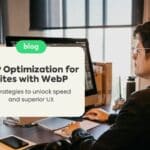INP Optimization for Sites with WebP: 6 Strategies to Unlock Speed and Superior UX
Implementing WebP and Optimizing INP: Advanced Strategies to Speed Up Your Site and Enhance User Experience in High-Traffic Environments

Site sluggishness and poor user experience negatively impact engagement, conversions, and revenue. Optimizing Interaction to Next Paint (INP) is crucial for high-traffic sites, yet integrating image formats like WebP can be challenging. Discover how to optimize INP for sites using WebP to provide a superior user experience. This detailed article presents best practices and strategies for optimizing INP on sites utilizing WebP, focusing on experienced editors and developers.
Understanding INP and Its Importance
The INP metric (Interaction to Next Paint) measures the time it takes for the browser to respond to the user’s first interaction, such as a click or scroll. A high INP indicates slowness and user frustration, negatively impacting engagement, conversions, and revenue. Optimizing INP is essential for providing a smooth and responsive user experience, especially on high-traffic sites.
The Benefits of INP Optimization
- Improved User Experience: Greater engagement, time on page, and conversion rate.
- Enhanced SEO: Greater visibility in search results.
- Reduced Bounce Rate: Fewer visitors leaving the site before completing the desired action.
- Increased Conversion: More leads, sales, and revenue.
Challenges of Integrating WebP and Optimizing INP
WebP, a high-quality and smaller-size image format, can be challenging to optimize concerning INP. It is crucial to find a balance between image quality, file size, and loading performance. Traditional image optimization techniques may not be sufficient for WebP.
Advanced Strategies for INP Optimization for WebP
- Specific Image Optimization for WebP: Use advanced tools and techniques to optimize WebP images without compromising quality.
- Lazy Load: Load images only when they are visible on the screen, reducing initial loading time.
- Content Prioritization: Prioritize the loading of critical page elements, such as text and images above the fold, for a faster initial experience.
- Minification and Compression: Minify and compress CSS, JavaScript, and HTML files to reduce page size and improve loading time.
- Server Optimization: Use server optimization techniques, such as caching and CDN, to deliver content more efficiently to users.
- Monitoring and Analysis: Regularly monitor and analyze INP performance to identify improvement areas and continuously optimize.
Essential Tools and Resources for INP Optimization
- PageSpeed Insights: A free Google tool to analyze site performance and provide optimization suggestions.
- WebPageTest: A free tool to test site loading time and identify performance bottlenecks.
- Lighthouse: A web performance audit tool integrated into Chrome Developer Tools.
- WebP Images: Use online tools to convert images to the WebP format without compromising quality.
Conclusion
Optimizing INP for sites with WebP requires technical expertise and a deep understanding of web performance best practices. By implementing the advanced strategies presented in this article, experienced publishers and developers can offer a superior user experience, boost engagement, increase conversions, and maximize revenue.
Contact Grumft!
Grumft offers innovative monetization solutions that do not compromise the user experience or INP optimizations of your site. Our specialists are available to help you achieve your business goals.
Contact us today and discover how we can help you optimize your site for INP and WebP!
Leia também:

Tu WordPress es un Rascacielos Digital. ¿Estás Ignorando las Grietas en sus Cimientos?

Your Slow Website is Costing You a Fortune. Here’s How to Prove It.

SEO 2025: Publishers’ Ultimate Guide to Dominate Search & Monetize Traffic
Autor(a):
Fernanda Calandro
Online desde 1997, sou uma profissional de marketing e conteúdo com formação robusta em marketing. Especializada em simplificar temas complexos através das minhas redações, eu facilito a conexão entre publishers e especialistas, promovendo um entendimento claro e acessível.
